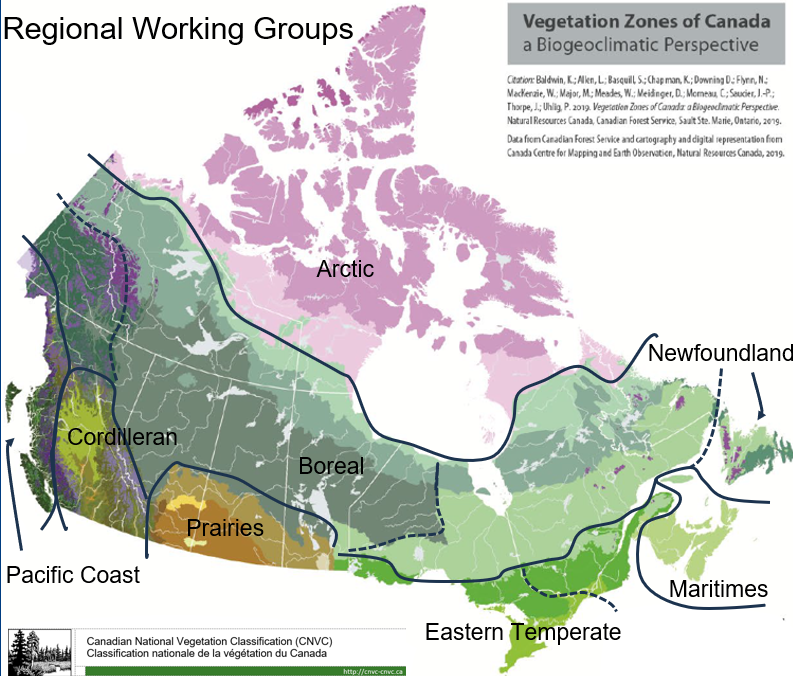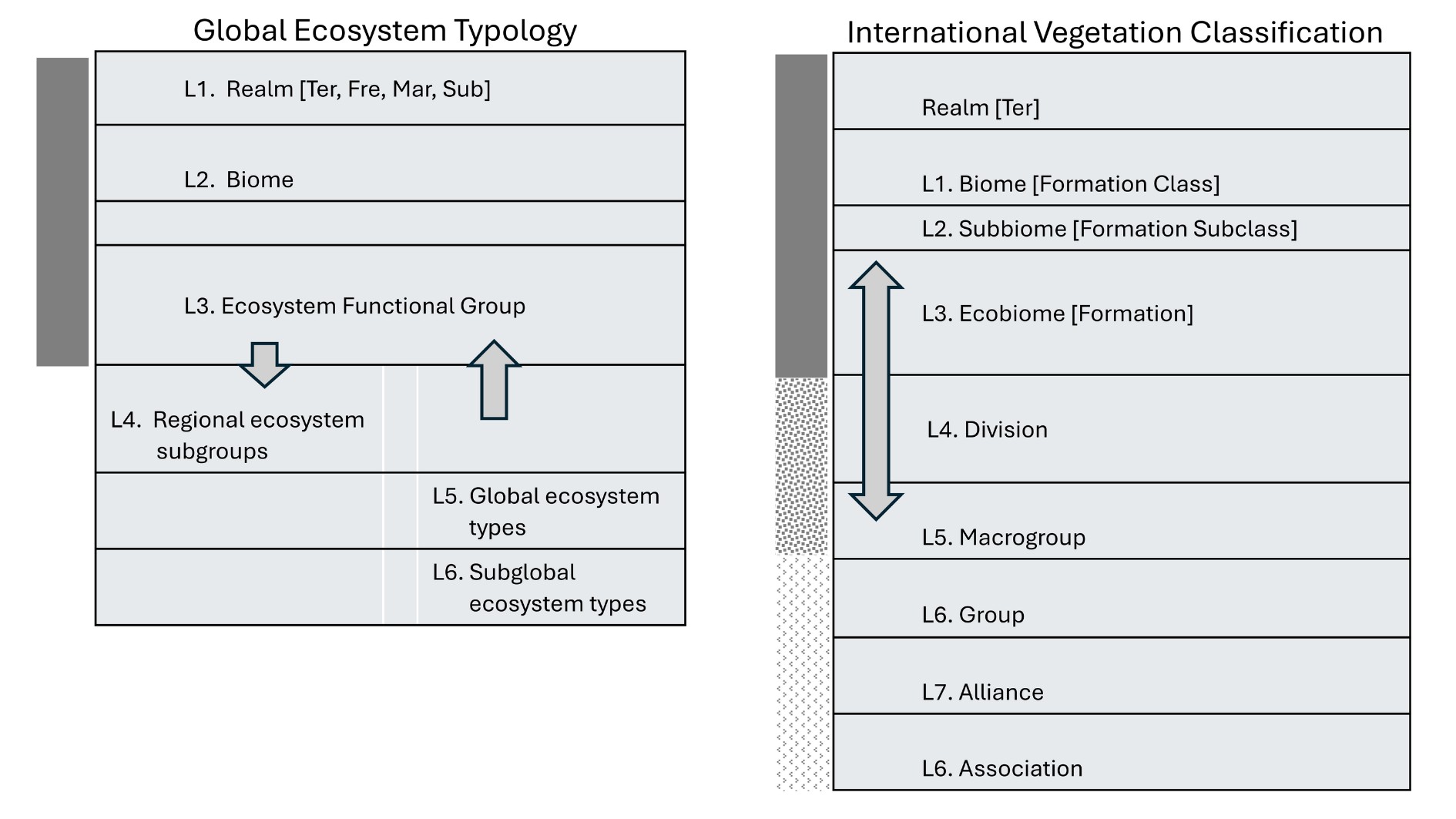NatureServe Canada is leading a multi-agency/organization partnership to support the development of a national vegetation classification that defines and describes all terrestrial ecosystems. Currently, the CNVC project is being funded by Environment and Climate Change Canada with the goal of completing a synthesis of terrestrial (including wetland) ecosystem types by 2028.
What is the CNVC?
The Canadian National Vegetation Classification (CNVC) is a hierarchical classification that describes and classifies all of Canada’s terrestrial (including wetland) ecosystems, based on the integration of ecological drivers and vegetation properties at multiple scales. The classification can, in principle, describe all ecosystems in their current state, from natural to modified (e.g. old fields) to intensively managed (e.g. forest plantations), but the focus is on natural ecosystems. The primary goal is to capture the patterns of vegetation types across the landscape, from wetland shorelines and peatlands through mesic grasslands and rainforests to dry forests, rocky barrens, and tundra. Types at each level are systematically described using standardized names, specific definitions, and factsheet, and made publicly available to users.

Significance
The primary purpose of the CNVC is to provide a consistent, systematic, and authoritative classification and description of Canadian ecosystems, based on integrating vegetation patterns and ecological processes. The CNVC is an important tool for coordinating the exchange of ecosystem information among multiple user groups (e.g. provincial, territorial and federal governments, NGOs) to support research and land management activities in the following ways:
• Serve as a standardized ecological framework, linked to jurisdictional classifications
• Provide ecologically meaningful units for reporting
• Support monitoring and predicting change
• Inform ecosystem-based management in the context of ecological land classifications such as the Canadian Terrestrial Ecological Framework
• Assist in conservation planning to assess status and trends in ecosystem condition, loss, and restoration.
National and Jurisdictional Collaboration
The CNVC project relies on extensive collaboration and investments by provincial, territorial, federal governments, and conservation organizations. All project activities are coordinated by the CNVC Technical Committee, which has representation from across agencies and organizations. The committee meets regularly to review progress towards meeting the goal of a national synthesis of Canada’s vegetation. In the past, the Committee collectively focused on vegetation types within the boreal forest biome, which stretches across all jurisdictions in Canada. Recently, the Committee has established Regional Work Groups across Canada to compile, analyze, and refine vegetation types within the distinct biomes of each regions.

The NatureServe Canada Network – Conservation Data Centres
NatureServe Canada plays a key role in the application of the Canadian National Vegetation Classification through its commitment to advance ecosystem assessments across Canadian jurisdictions. Through its Network of Conservation Data Centres (CDCs), NatureServe Canada works to acquire, review, update, and maintain standard classification, mapping, and status assessments for ecosystems in Canada.The CNVC data are housed within the Biotics database, maintained by NatureServe Canada and NatureServe (North America), and the database is routinely updated in collaboration with partners. The goal is to ensure that the CNVC information remains accessible and useful for conservation planning and natural resource management within each jurisdiction and across the country.
International Collaboration
The release of the Global Ecosystem Typology (GET) [link] by the International Union for Conservation of Nature (IUCN) presented an opportunity to revisit the CNVC hierarchy and NatureServe’s International Vegetation Classification (IVC), which share a common ecosystem classification approach, called “EcoVeg”. Through extensive collaborations between authors of the GET and EcoVeg approaches, a biome-based revision to the CNVC was produced that builds on the strengths of GET for global terrestrial types and the CNVC for continental to local terrestrial ecosystems [link] (Figure 3). The revisions provide more robust opportunities for co-application of the CNVC, IVC and GET in the terrestrial realm for management, conservation, and restoration.

CNVC 2022-2028 Project
Goals
Classify:
- Develop standardized terrestrial vegetation types for Canada.
- Classify Canadian vegetation at various levels of generalization, from biomes (e.g. Temperate-Boreal Grassland & Shrubland) to regional (e.g., Great Lakes Alvar) and local plant communities (Northern Dropseed – Little Bluestem Alvar Grassland) (see Figure 1).
- Describe each types using factsheets, and make them publicly available.
Coordinate:
- Engage Canadian government agencies and partners with relevant expertise, data and jurisdictional authority in order to complete and map the classification with the greatest degree of national consensus.
- Coordinate and correlate CNVC vegetation types with Canadian provincial, territorial and regional classifications, as well as with the U.S. National Vegetation Classification (USNVC) and the Global Ecosystem Typology.
- Support survey and mapping of CNVC in collaboration with federal, provincial, and territorial agencies and NGOs.
Communicate:
- Communicate to a wide audience of potential users the need for, and utility of, a standardized national classification of vegetation types for Canada.
- Provide publicly accessible descriptions of Canadian vegetation types.
Project Updates
Prior
2019: Standards for development of CNVC and a comprehensive list of CNVC macrogroups
2020: Completion of eastern Boreal forest types, drafts of western boreal and all temperate forest types
Current April 2022 – March 2028
2022: Preliminary synthesis of CNVC groups, alliances, and associations within CNVC macrogroups.
2023: Several projects:
- Assignment of alliances to Quebec temperate forest types;
- Description of Newfoundland’s non-forested types
2024: Several projects:
- Grasslands analysis in Prairie Provinces (AB, MB, SK);
- Grasslands of Canada report and at risk Assessment (in support from Canadian Forage and Grassland Association)
2025: Several projects
- Description of all temperate vegetation types in Prairie Provinces (AB, MB, and SK)
- Review of Arctic vegetation types in context of Circumboreal Arctic Vegetation Map and Alaskan Arctic team review.
- Assessment of Rocky Mountain vegetation in Alberta
- Quantitative vegetation analysis workshop
- Preparation for revisions to cnvc-cnvc.org website.
Learn More:
- Canadian National Vegetation Classification: Principles, Methods and Status (Baldwin et al. 2019)
- Eastern Boreal Forests (Chapman et al. 2020)
- Vegetation Zones of Canada (Baldwin et al. 2021)
- Canadian National Vegetation Classification: Status report of units described in Canada [draft] and Appendix B (Faber-Langendoen et al. 2022)
- Newfoundland non-forested report (Meades et al. 2023)
- Prairie Province Grasslands Report (Wells et al. 2024)
- Grasslands of Canada (Faber-Langendoen et al. 2024)
- Advancing the EcoVeg approach as an ecosystem typology: from biomes to local plant communities (Faber-Langendoen et al. 2025; accepted Ecosphere)